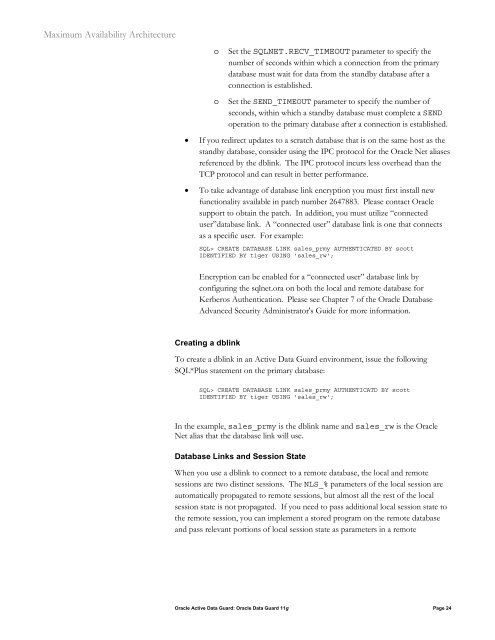MAA - Oracle 10gR2 Redo Transport and Network Best Practices
MAA - Oracle 10gR2 Redo Transport and Network Best Practices
MAA - Oracle 10gR2 Redo Transport and Network Best Practices
You also want an ePaper? Increase the reach of your titles
YUMPU automatically turns print PDFs into web optimized ePapers that Google loves.
Maximum Availability Architecture<br />
o Set the SQLNET.RECV_TIMEOUT parameter to specify the<br />
number of seconds within which a connection from the primary<br />
database must wait for data from the st<strong>and</strong>by database after a<br />
connection is established.<br />
o Set the SEND_TIMEOUT parameter to specify the number of<br />
seconds, within which a st<strong>and</strong>by database must complete a SEND<br />
operation to the primary database after a connection is established.<br />
• If you redirect updates to a scratch database that is on the same host as the<br />
st<strong>and</strong>by database, consider using the IPC protocol for the <strong>Oracle</strong> Net aliases<br />
referenced by the dblink. The IPC protocol incurs less overhead than the<br />
TCP protocol <strong>and</strong> can result in better performance.<br />
• To take advantage of database link encryption you must first install new<br />
functionality available in patch number 2647883. Please contact <strong>Oracle</strong><br />
support to obtain the patch. In addition, you must utilize “connected<br />
user”database link. A “connected user” database link is one that connects<br />
as a specific user. For example:<br />
SQL> CREATE DATABASE LINK sales_prmy AUTHENTICATED BY scott<br />
IDENTIFIED BY tiger USING 'sales_rw';<br />
Encryption can be enabled for a “connected user” database link by<br />
configuring the sqlnet.ora on both the local <strong>and</strong> remote database for<br />
Kerberos Authentication. Please see Chapter 7 of the <strong>Oracle</strong> Database<br />
Advanced Security Administrator's Guide for more information.<br />
Creating a dblink<br />
To create a dblink in an Active Data Guard environment, issue the following<br />
SQL*Plus statement on the primary database:<br />
SQL> CREATE DATABASE LINK sales_prmy AUTHENTICATD BY scott<br />
IDENTIFIED BY tiger USING 'sales_rw';<br />
In the example, sales_prmy is the dblink name <strong>and</strong> sales_rw is the <strong>Oracle</strong><br />
Net alias that the database link will use.<br />
Database Links <strong>and</strong> Session State<br />
When you use a dblink to connect to a remote database, the local <strong>and</strong> remote<br />
sessions are two distinct sessions. The NLS_% parameters of the local session are<br />
automatically propagated to remote sessions, but almost all the rest of the local<br />
session state is not propagated. If you need to pass additional local session state to<br />
the remote session, you can implement a stored program on the remote database<br />
<strong>and</strong> pass relevant portions of local session state as parameters in a remote<br />
<strong>Oracle</strong> Active Data Guard: <strong>Oracle</strong> Data Guard 11g Page 24

















